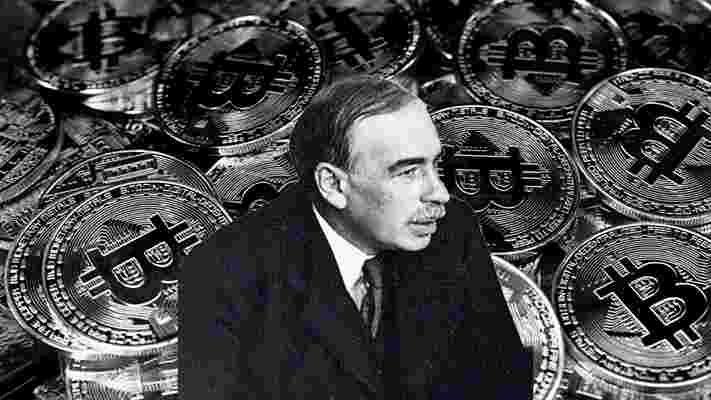John Maynard Keynes (1883-1946) was the greatest economist of the twentieth century. Less well known is that he had a parallel career as a successful investor : fairly successful early in his career, and spectacularly successful later on when he changed his strategy.

After the first world war, his income depended more on his investments than his academic work.
In addition to his personal investments, he managed the investments of King’s College, Cambridge, of which he was a member.
Under his stewardship, the value of the King’s College fund increased twelve-fold over a period in which broader markets failed to even double.
It was said Keynes achieved these high returns while only devoting half an hour every morning to the task before he got out of bed.
Keynes quoted approvingly to his friends a line from Volpone , a classic poem:
He most certainly did seem to more highly value the cleverness with which he made money than the money itself. He saw strategy as an alternative to art for someone without the requisite talent.
The younger Keynes
Keynes as a young man was very confident about his own abilities, and less so about those of the general investing public.
In his early investments, he tried to benefit from market timing, staying just ahead of the crowd.
Compared to the crowd at this time, the young Keynes invested more in equities (shares) than in bonds (debt).
He also speculated on exchange rates and commodities. And he was far more willing than the crowd at the time to invest outside his country, being fond of Australian government bonds.
Among his portfolio were modern artworks . Some were by his friends but – judging by the records he kept of their prices – some also served as investments.
He spent ₤13,000 amassing art that was valued at ₤76 million in 2019.
Keynes’s artistic judgments produced an annual real rate of return of 6% , which is similar to what he might have earned from shares. But it provided him with what shares could not – what the artistic and literary Bloomsbury Group, of which he was a part, called “ the enjoyment of beautiful objects ”.
This younger Keynes might certainly have thought about Bitcoin, believing he could buy into something before it got big, and then sell out in time.
But the formula didn’t always work, even for him.
The older, wiser Keynes
The older Keynes switched to value investing, carefully selecting and holding stocks offering prospects of good long-term returns. This proved more successful .
He now regarded trying to get the timing of cyclical investments right as “impracticable”, saying most who attempt it “sell too late and buy too late”.
He wrote that most who try it concentrate too much on capital appreciation and too little either on “immediate yield or on future prospects and intrinsic worth”.
One of today’s most successful investors, Warren Buffett , has written of his admiration for Keynes’ brilliance and emulated his style .
Shortly before his death, Keynes warned of the dangers for investors of joining bandwagons. As he put it
During this most successful period Keynes avoided bets on products with no fundamental value.
And he was worried about them for broader reasons. As he put it in his 1936 General Theory
The latter-day Keynes would not have bought Bitcoin and might have even preached against it.
This was the Keynes whose investments were the most successful.
Article by John Hawkins , Senior Lecturer, Canberra School of Politics, Economics and Society and NATSEM, University of Canberra and Selwyn Cornish , Adjunct Associate Professor, Research School of Economics, Australian National University
This article is republished from The Conversation under a Creative Commons license. Read the original article .
Moonday Mornings: Ethereum Classic hackers return $100K worth of stolen funds
It’s another Monday and that means we have another Moonday Mornings for you.

Here’s what you need to catch up on from over the weekend.
1. Nine cryptocurrency mining firms have decided to band together and sue a Washington State utility company after it raised electricity costs. The lawsuit claims the energy supplier operated inappropriately when it created a new rate to raise electricity costs, Bitcoinom reports. The energy provider, Grant PUD, said the new rate is designed to reduce risk and provide competitive rates to its retail customers.
2. Despite coming up against numerous challenges the Marshall Islands is showing no signs of easing up on its dream of creating a national cryptocurrency. The firm developing the Islands’ national cryptocurrency, the Sovereign (SOV), announced on its Medium blog that it recently hired Steve Tendon as an advisor. Tendon is the man behind Malta’s transformation to becoming a blockchain hub, SOV are clearly hoping he can work his magic in the Marshall Islands.
3. Paris‘ Bitcoin street mural puzzle has been solved, reports to CryptoGlobe . The artist, Pasal Boyart, announced that someone had claimed the prize and transferred the 0.29 BTC that sit in the prize pot. There had been a number of public donations to the mural too, so the lucky mastermind made off with just over $1,000 worth of BTC at the time fo writing.
4. After being hacked for over $1.1 million in a 51-percent attack, Ethereum Classic has seen $100,000 of the lost funds returned. Cryptocurrency trading platform Gate.io, announced the attacker returned the money on January 10, only a few days after the original hack took place. According to Gate.io, the Ethereum Classic network is still not strong enough, and may be susceptible to future attacks.
5. South Africa‘s national cricket organization dropped the ball recently after falling foul to cryptocurrency scammers on Twitter, the Indian Express reports. Tweets from the official South African Twitter account claimed it was working with Luno money for the first South African Bitcoin lottery. The scammers asked followers to send some BTC to an address to be entered into the lottery with a chance to win 20 BTC. Alas, this wasn’t to be, in the true scammer cliché, they took the money and ran.
It was another week of regulation, hacks, scams, and lawsuits. But there you have it, another weekend of cryptocurrency and blockchain news caught up with so now we can get on with our weeks.
‘Blockchain’ is now more popular than ‘cryptocurrency,’ according to Google data
It’s not the flippening everyone has been talking about, but Google search data reveals people are finally starting to show more interest in blockchain than cryptocurrency.

Following the massive hype cycle at the end of last year, Google Trends suggests the term ‘blockchain’ is gradually becoming a more popular search criteria than ‘cryptocurrency.’
trendmbedenderExploreWidget("TIMESERIES", {"comparisonItem":[{"keyword":"/m/0vpj4_b","geo":"","time":"today 12-m"},{"keyword":"/m/0138n0j1","geo":"","time":"today 12-m"}],"category":0,"property":""}, {"exploreQuery":"q=%2Fm%2F0vpj4_b,%2Fm%2F0138n0j1&date=today 12-m,today 12-m","guestPath":"https://trends.googleom:443/trends/embed/"});
The first time ‘blockchain’ briefly overtook ‘cryptocurrency’ (after last year’s hype) was in July. And it has consistently attracted more searches than ‘cryptocurrency,’ since at least September.
In all fairness, Bitcoin continues to be the most commonly searched “crypto” term by far. Indeed, Google Trends suggests that ‘Bitcoin’ is nearly 10-times more popular than terms like ‘cryptocurrency’ and ‘blockchain.’
For the record, prior to 2017’s crypto-hype train, the data shows searches for the terms ‘cryptocurrency’ and ‘blockchain’ have remained relatively close in popularity over the past five years – with the exception of a few irregularities.
trendmbedenderExploreWidget("TIMESERIES", {"comparisonItem":[{"keyword":"/m/0vpj4_b","geo":"","time":"today 5-y"},{"keyword":"/m/0138n0j1","geo":"","time":"today 5-y"}],"category":0,"property":""}, {"exploreQuery":"date=today%205-y&q=%2Fm%2F0vpj4_b,%2Fm%2F0138n0j1","guestPath":"https://trends.googleom:443/trends/embed/"});
It’s worth pointing out that Trends only shows the relative popularity of a search term. “The resulting numbers are then scaled on a range of 0 to 100 based on a topic’s proportion to all searches on all topics,” Google explains . As such, there is no telling what the real numbers for ‘blockchain’ and ‘cryptocurrency’ searches are.
In any case, I guess the meme that crypto-enthusiasts are really ‘in it for the tech’ is for once not that far off from the truth – according to the numbers, at least.
On a more serious note though, the sentiment that blockchain (the technology) will outlast cryptocurrencies (like Bitcoin) is slowly materializing into a popular mainstream narrative. Indeed, JP Morgan CEO Jamie Dimon recently reinforced this same line of thinking in an interview at Axios Conference.
Let’s see how long this trend lasts.











